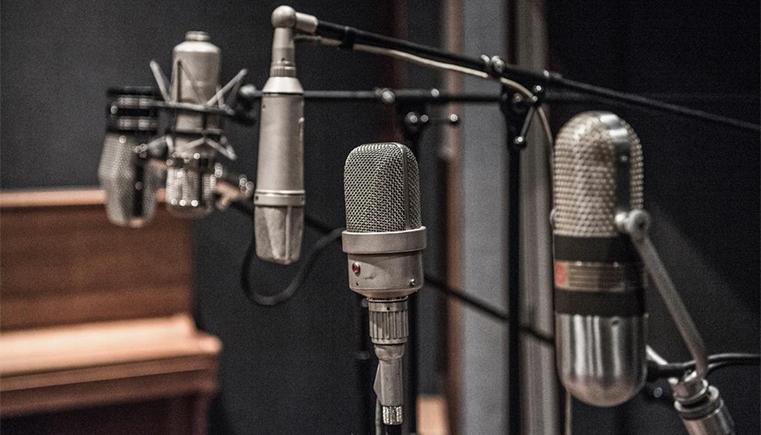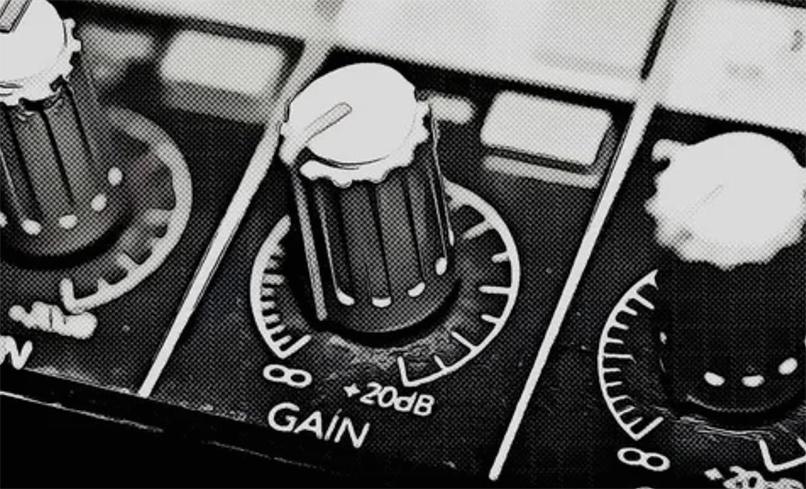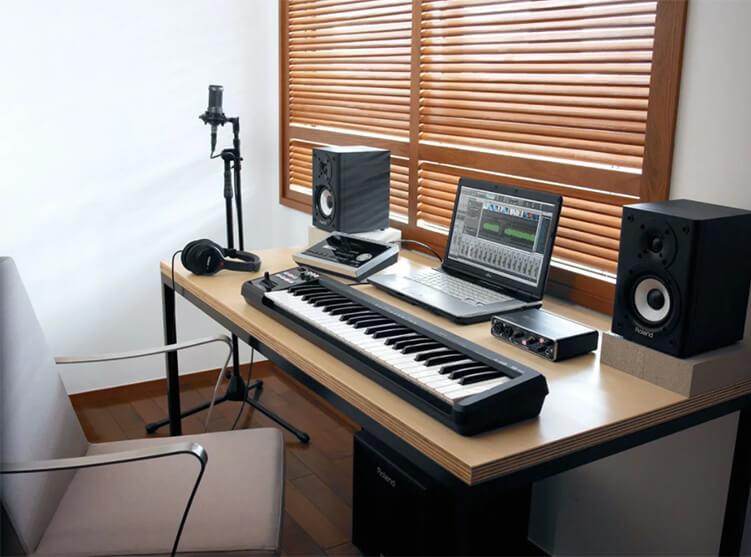How to read guitar sheet music

It’s nice to discover new music. You want to immediately pick out the chords, solos, guitar arpeggios, learn all this beauty and repeat endlessly. But not everyone can make a song out by ear. Besides, it takes time a lot to figure it out. That’s why musicians need to know how to read guitar sheet music. We read sheet music when we’re learning new exercises to sharpen our technique, when we’re learning to play classics or world-class hits, and when we’re picking apart beloved songs.
Knowing how to read guitar sheet music is also useful when you’re working in a group. They’re used to sharing musical ideas, exchanging tips and helping each other think of melody and harmony ideas. It is even necessary just not to forget the newly composed line. Then you can return to it, refine and develop it. See how you can read sheet music and symbols for guitar in different notation formats.
Marking methods
The traditional and universal method for all players is to use a scroll wheel on the stave (notepad). This can be used to record the part of any instrument. Music schools and classical schools graduates have sheet music a good grasp, at least know the basics. Reading guitar sheet music and playing it instantly on the fingerboard is a skill that takes years to master. If you’ve only learned to recognize notes and understand durations, it’s already an achievement.

Traditional musical notation
For many guitarists, mastering chords is enough. They don’t need to understand how to read guitar notes. They know which strings to press to get a particular chord. By changing fingering, they already create harmonic sequences and can, for example, accompany themselves for singing. But to do this, you must learn the chord symbols and the circuitry by which they are fingering.

Bm chord scheme
And perhaps the most common way for all levels guitarists to read guitar notes is tablature. It can be handled by beginners and professional players alike. It’s a handy and flexible notation. With it, you can convey a harmonic or melodic part in a generalized way, without detail. But for this format, many symbols denote strokes and rhythmic nuances. In this article, we will consider notations and chord notation in all three types, but we will pay special attention to tablature.

Tablature in simplified form
You can read how to use Amped Studio music editor and try to compose your own melody from sheet music online.
How to read guitar sheet music in classical notation
The musical scale is five lines’ made up. The notes are indicated by ovals and are placed on and between the lines. Some lack stanza, and are placed on additional lines (for example, C in a treble clef). The curled figure at the beginning of the line is the treble clef. It indicates that the first line is for the note in E, the second in G, the third in B, the fourth in D and the fifth in F (the position is different in the bass key). Between the lines and below and above them are places for D, F, A, C, E, G. To read guitar notes, you need to know their correspondences on the fingerboard. Here they are.
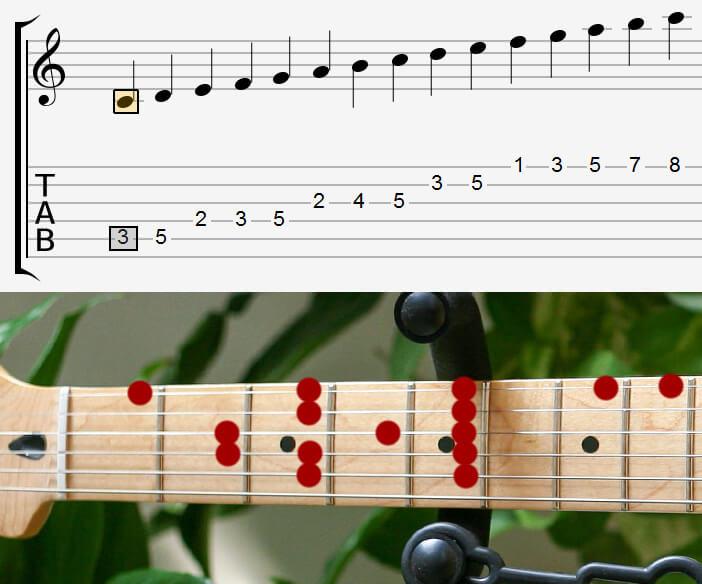
Gamma in C major in two octaves on the fingerboard
The C major and A minor scales fit perfectly on the fingerboard. On the piano keyboard, the white keys correspond to them. To denote the black keys or guitar harmonies sounds from other tonalities, we have to use the dieses and the flat bars, in music some pieces some bekars cancel out the dieses and the flat bars. To have how to read notes on the guitar a basic understanding, is enough for us. Let’s not delve into musical notation.
But it’s important to have rhythm and durations a general idea. Reading durations is more difficult than reading oval notes. At the beginning of a line, behind the key, we see numbers. Most often it will be ‘4/4’ – four quarters. This means that the measure is divided into four quarter notes, we can count them: ‘one-two-three-four’. You add two halves or one whole note. And we can divide them into eight eighths (“one-two-three-fourths”), sixteenths or even smaller. Plus we have pauses with the same durations. Combining all these, we get rhythmic patterns. Here’s the durations whole set.

Whole note and whole pause (placed under the fourth ruler)

Half and half pause (placed above the third ruler)

Quarter
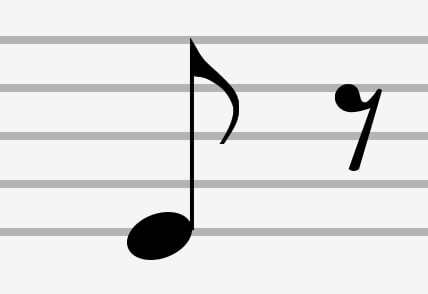
Eighth

Sixteenth
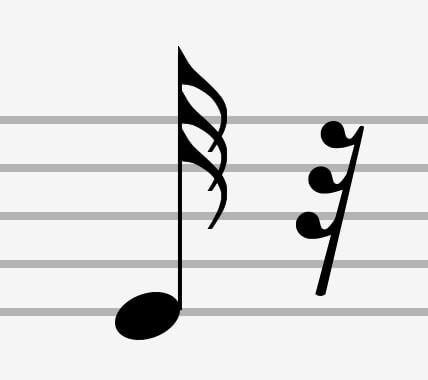
Thirty-second

Sixty-fourth
Difficult? Reading guitar sheet music in its classical form is difficult in principle. And to understand durations right off the bat is to be at musical notation at an advanced level. But not all musicians need this, so we use recording more other ways. There are much simpler ways to read guitar notes and write them down. To these, we’ll go.
Chords
When we play several sounds at once we get chords, seventh chords, sextakords, nonachords and other chords. Traditionally, they are written as ovals, one under the other. But it’s easier to give each chord a letter designation and use the letter combinations all the time. This makes it very easy to read guitar sheet music. In this case, we don’t need a music stand, we can write the chord letter directly above the lyrics. The easiest and most popular are C, Am, E, Em, D, Dm, G, F.

Common chords in the sheet music, tablature and charts form
But you have to learn how to place them correctly. There are a lot of diagrams for that. The six horizontal lines are the strings: the thickest at the bottom and the thinnest at the top. They are shown upside down because you are looking down at the guitar fingerboard, and the thickest string is closer to you, as if from below. The vertical lines are the frets. The dots represent the fret to be clamped. There are also rotated patterns where the strings are vertical and the fret is horizontal. Now you know how to read guitar sheet music using letters and patterns.
Composers and jazz musicians use an even more convenient method. They read chords in steps and indicate them with Roman (and sometimes Arabic) numerals. So, in A-minor Am becomes I (1), Bdim becomes II (2), C becomes III (3), Dm becomes IV (4), Em becomes V (5), F becomes VI and G becomes VII. When jazzmen need to move to a different key, they do not rewrite all the chords but use the same numbers. This is how guitar sheet music another example is read in the music world.
Tablatures
Someone combined classical notation with chord schemes and the result was tablature. This is the labelling’ any guitar part most convenient form, both chordal and melodic-monophonic. While you can arrange the score for any instrument on a notepad, tablature is the only way to record guitar parts or, for ukuleles, with four rulers.
How do I read guitar sheet music in tablature? Like the diagrams, the horizontal lines indicate the strings. The thickest at the bottom, the thinnest at the top. The numbers indicate the fret at which the strings are to be clamped. Read from left to right, playing the numbers in order. Where there is 0, pull the open string. The process resembles a computer game. Let’s look at an example.

Here the melody is combined with chords. First, we see a triad: the left-hand clamps the strings on the first, third and second fret. Then we pull the open first string and put a triad again, but on the other strings. And so on. Looking around the whole piece, you will see that the chords here alternate with a single note on the open first string. You just have to figure out their arrangement and hone your finger alignment. We also see arcs and oblique lines. About that a little later.
Reading guitar sheet music this way is very handy. But this is a general kind’ a tablature. There’s absolutely no rhythm information here. If you know how a tune should sound, you’ll play it in the right rhythm, with the right durations and pauses. To break down a popular song, this generalised format will work. But to record a new part and mark its rhythmic pattern, you’ll already need tempo flags.

Same tablature along with notation and durations
But still, we don’t have complete information yet. The tablature another (extended) version shows how to read guitar notes to make them sound classy, high-quality as if played by a professional. Good guitarists don’t just strum and strum, they use techniques a variety and attention a lot to nuance. This all can also be displayed on the tablature.
Tabs with strokes
Hammer-on. This technique is also called “ascending legato”. When you read the guitar sheet music, pay attention to the arcs that join the numbers in pairs. This means that the two sounds must sound together, with no pause between them. On a piano, this is easy to do: release the first key exactly as you press the second. On a guitar, the attack is more distinctive. And legato here means something different: that the first sound will have an attack, but the second sound will have virtually no attack.
How do you technically implement this technique when reading guitar notes? The first digit is played with the plectrum, the second with just your left-hand finger. Let’s say you jam the string with your index finger. To do a hammer-on, you jerk the string with your pick and then hit the next fret with your left-hand middle finger without your index finger letting go. If you simply write your tabs in a text editor, a hammer-on can be represented by an “h” or a “^”: for example, “5h6” (“5^6”).

Hammer-on
Pull-off. This is a reverse movement – a descending legato. If you read guitar sheet music in text form, you will encounter the letter “p” or the “^” symbol: “6p5” (“6^5”). Either pool-off is denoted in the same way as a hummer, with a connecting arc. Technically it is implemented as follows: you clamp two neighbouring frets (or two fret frets through one fret), use your plectrum to play the first sound and to get the second one you need to pull off your middle finger, then your middle finger plays the note on the previous fret.

Pull-off
Muffle. How do I read guitar notes marked with crosses? Place your left hand on the string, but don’t squeeze it. Then strike the plectrum – you should get a percussive sound without a tone. These clicks are also called ‘dead notes’. They’re used to dilute a solo or bridge tight melodic lines.

Dead notes
You may also come across the designation “pm”. This is an acronym for the Palm Muting technique. It produces a similar “dead”, muffled sound, but you can already hear specific notes in it. To play it, clasp the string with your left hand while your right-hand palm lightly presses the strings near the tailpiece with your pinky finger and operate the pick.

Palm Muting
Slide. In tabs, guitar notes can be written with a slash (“/”) or the letters “sl”. Or a straight line is drawn between the numbers. Read it this way. Play the first digit with the pick and slide your finger to the next fret without taking your finger off the fingerboard. You get a glissando effect. It can be downward as well as upward.

Slide
Bend. In the guitar tabs, you’ll see numbers separated by a “b”. Read them like this. Clamp the note, carve a sound with your plectrum and pull the string upwards (sometimes it’s more convenient to pull it downwards), a long metal fret. Pull it up until the moment when it sounds like the next fret, i.e., half a ton higher (sometimes you even need to bend it a ton higher). The second number corresponds exactly to the next fret pitch. This stroke is also indicated by a curved or broken line.

Bend
Lever movement. Not every guitar has a lever (especially an acoustic one). So, you may not be able to adequately read the techniques all found in tablature. If the note is represented as “7\5/7” or something similar, you need to quickly push the lever to get a sharp pitch. The number inside ‘\ /’ indicates the semitones number you need to move down. The reception is also indicated by a “v”.

Lever movement
Vibrato. This stroke is used by guitarists for almost every long note. At a phrase end, it is particularly noticeable and expressive. In the tabs, it is represented by “~” and “x”. Reading them with your guitar is easy. Grip the string at the fret you’ve specified, play the sound, and gently move your finger up and down to change the pitch. The amplitude should be small and the movement should match the song rhythm. Sharp vibrato is also done by swiping along the fingerboard, left to right. This requires a bit more effort.

vibrato
Trill. Technically, it’s the Hammer-on and Pull-off combination a repetition. Hold down the reference note and while holding it, repeatedly strike the adjacent fret with the other finger. This is how you read “tr” and “tr~~~~”. This is more common on the piano. On the guitar, it is not often played this way, most intense moments to convey anticipation a state before a powerful resolution.

trill
Tremolo. How do you read guitar sheet music when a single digit is repeated many times in the tabulation? We play it as several fourths or eighths. But if you want to turn it into sixteenths or thirty seconds, that is, play a tremolo, you use a special symbol or letter combination called a “TR”. Sometimes it is followed by ‘~’ to give how long it lasts an approximate idea. A tremolo is created by making a rapid, rhythmic up-and-down movement with the plectrum. Typically, the beats are in the sixteenth, thirty-second or sixty-fourth beats, depending on the song tempo.

Tremolo
Tapping. This technique can as an optimized Hammer-on be thought’. When you read the sheet music for the guitar, tapping will most likely come across a complex combination like “5h7t10p7p5”. You hit a fingering finger on a fret, like with a hammer-on, but it’s your right-hand finger, not your left. Pull-off, of course, is done with the same finger. In this way, you use both hands, just like when you play the keyboard. It’s a great way to increase your speed and get a specific sound.

Tapping
Flageolets. Flage notes take on a smooth, airy sound when you play them with your guitar. Natural flageolets are taken in triangular brackets: “< >”. How do you read it with the instrument? Lightly touch the string above the metal fretboard with your left hand, play the tone with your right hand, and immediately remove your left thumb. And natural flageolets are on fret 12, fret 7 and fret 5 only. The faux-flage can be extracted anywhere, but it is quite difficult, it takes some practice. If you want to learn, figure it out on your own, there are many video tutorials on the web for faux-flage.
Practical advice on how to read guitar notes
Start by learning the chords. Mastering fingering patterns is easy. After that, it’s good to practice the transitions between chords. This will allow you to quickly switch fingerings without losing your rhythm. Just move from position to position many times in a row. At some point, you’ll notice that your hands start moving in the right direction automatically. By mastering the chords, you’ll be able to recognise them quickly on the tablature.
Learn to read the notes and symbols for the guitar in levels. First, practise finding your fret and clamping the string at the position indicated by the number. It’s a very simple exercise, the important thing here is to get yourself as much speed out as possible. Then start practising different strokes, tricks and techniques. You don’t need to use any specific tablature here; you can exercise autonomously. The third level – mastering of durations. When you begin to navigate them and quickly grasp the rhythmics, consider that you have almost reached the top. All that’s left is to learn classical music notation.
Break down specific songs. You’ve learned how to read guitar notes, but the musical experience doesn’t end there. Don’t limit yourself to the examples you met in the article. Take tablature with popular songs, solos, chords, and bridges guitar parts – and see what the hits are made of. It’ll not only help you learn how to read guitar sheet music; it’ll help you understand the logic behind famous composers, musicians, and guitarists.
Use handy software. There’s a special software program for working with tabs, like Guitar Pro. It lets you read guitar sheet music those other players have written and record your compositions. You can usually work with nuance and rhythm, as well as select a sound and write an arrangement, supplementing your project with other instruments.
Work with sequencers
Some music recording software includes a note mode. You arrange the notes on a grid by navigating a virtual piano key (it’s very simple). And the software translates everything into classical notation. It helps you get your head around durations and how to read guitar notes on the staff.
Conclusion
So, you’ve learned about chord labels, considered recording alphabetic and numeric ways, and understood how chord schemes are constructed. We touched upon the universal classical musical notation in passing and described in general terms how rhythmics is translated in the traditional method. And we took apart in detail the recording music for guitarists most convenient way. We learned about the different techniques, guitar playing techniques and what they are called.
Knowing how to read guitar notes isn’t for everyone. But it does help you save face and get your bearings quickly when you need to learn an unfamiliar piece in a hurry. If you assimilate all the information in the article, start using the recommendations and work’ off the techniques you just learned, you’ll raise your skill as a guitar player by several levels. Don’t delay.


